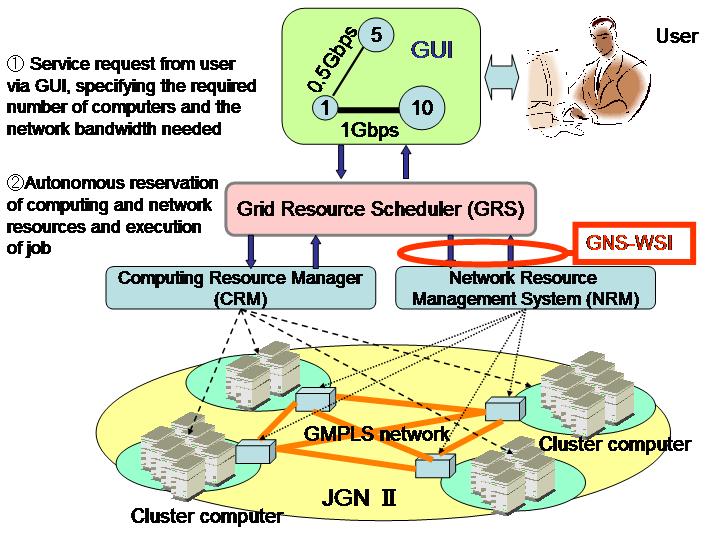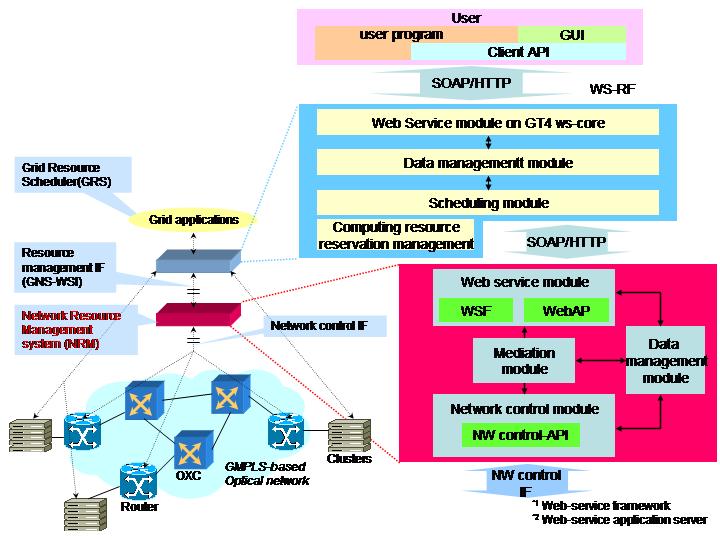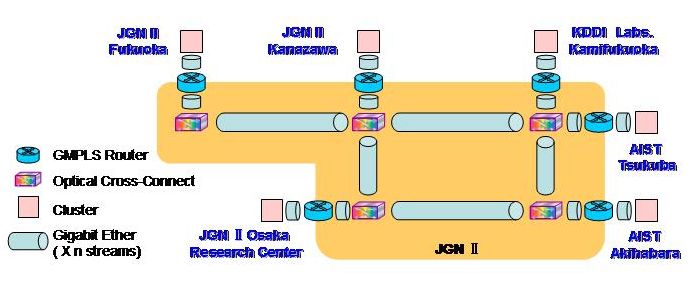Demo at iGrid 2005 In this demonstration, an application program is executed using computing resources and optical paths, both of which are scheduled and reserved in advance. The Grid Resource Scheduler (GRS) calls on a Network Resource Management System (NRM) to request optical paths on a GMPLS controlled network, specifying the end nodes’ locations and other requirements, such as bandwidth. NRM, in turn, checks the availability of the requested paths, reserves the paths, and sets up the paths when the scheduled time arrives. The goal of this project is to define a standard web service interface (GNS-WSI) between GRS and NRM, which is acceptable for both application service providers and commercial network operators, and which can be used as a tool for realizing emerging new commercial services. The Architecture An architectural framework is defined, where not only computing resources, but also network resources that connect computing resources, are recognized as part of the managed resources, and are dealt with integrally. In other words, the required network bandwidth is reserved through the co-functioning of the GRS, which reserves overall resources, and the NRM, which flexibly establishes optical paths, with adequate bandwidth between defined locations, all using the defined interface. For network control, GMPLS technology, which is currently undergoing standardization for the control of optical paths, is applied. Using this technology, it is possible to connect geographically distributed computers and/or storage devices freely on an as-necessary basis, using the appropriate transmission bandwidth. Furthermore, the potential for cost reduction, as well as drastic enhancement of both computation efficiency and usability (See Figure 1), is anticipated. Since resources to be provided and managed in a Grid environment are geographically distributed, the network which connects these resources is likely to extend over several regions and countries, and thus may be provided by multiple network operators. Therefore, it is important to have a common interface among network operators to enable the exchange of information that is required for co-functioning between the GRS, which manages the computing resources, and the NRM, which manages the network. We defined the basic functions of such an interface, the Grid Network Service Web Service Interface (GNS-WSI)  The Grid Resource Scheduler (GRS) We have developed a WS-RF (Web Service Resource Framework)-based Grid scheduling system that is capable of co-allocation of computing and network resources. The main module of the system is called GRS, which co-allocates computing and network resources with advance reservation. Computing resources are reserved through Computing Resource Managers (CRM), and network resources are reserved through NRM, as shown in Figure 1. To co-allocate computing and network resources, Grid Scheduler negotiates with CRM of computing resources and NRM provided by network operators and co-allocates computing and network resources for each user requirement. We implement a prototype of reservation-based GRS architecture using Globus Toolkit 4 (GT4), a WS-RF reference implementation written in Java. As shown in Figure 2, GRS consists of the following modules: The Client API and GUI are programming and graphical user interfaces. The Web Service Module provides a reservation service interface based on WS-RF. This module creates a Reservation Resource instance for each user request, stores the instance in the Data Management Module, and returns the EPR (end point reference) to the user. The user accesses the EPR to get the current scheduling status and the result. The Reservation Resource is a reservation service entity made available for each user reservation request. The Data Management Module stores the state of each reservation process persistently, and guarantees recovery from failures. Co-allocator called the Scheduling Module negotiates with CRM and NRM and co-allocates suitable computing and network resources for user requirements. If the co-allocator cannot find resources to meet the specified deadline, the Reservation Service returns the “Reservation Failed” status and the user re-submits the reservation request. The Computing Resource Reservation Management manages the status of advanced reservation on each site managed by CRM. The Network Resource Management System (NRM) To enable a lambda-based grid network service (GNS) over a GMPLS optical network infrastructure for grid applications, NRM is configured with three key functional modules. In the Web Service Module, NRM equips a GNS web-service interface (GNS-WSI), called a resource management interface, defining service conditions and procedure, based on the WSDL. By using indirect invocation with the GNS-WSI, RPC-based SOAP/HTTP messaging between NRM and a global grid brokering system, GRS achieves discovery of network resources, reservation of dedicated lambda paths, and modification of the network service. In the Mediation Module, NRM provides resource abstraction and local scheduling functionalities to mediate between the request from GRS and the network resource. In the mediation process, NRM virtualizes GMPLS-controlled dynamic optical networks as lambda paths between cluster sites for grid applications. Scheduling of lambda paths is also conducted in the mediation module. In the Network Control Module, NRM controls GMPLS routers as network edge devices through the network control interface to activate required lambda paths and to monitor their states and performance. Overview of the Demonstration Summary We have defined a preliminary interface between a grid scheduler and a network resource manager, GNS-WSI, and conducted a demonstration using GRS, NRM, and a GMPLS-based network test bed of JGN II.In the future, we will focus on detailed specifications of the GNS-WSI, and are aiming to make this technology both open, and a global standard. Members Grid Technology Research Center, National Institute of Advanced Industrial Science and Technology (AIST) Tomohiro Kudoh, Hidemoto Nakada, Atsuko Takefusa, Yoshio Tanaka, Yusuke Tanimura, Hiroshi Takemiya, Fumihiro Okazaki, Satoshi Sekiguch KDDI R&D Laboratories: Masatoshi Suzuki, Hideaki Tanaka, Tomohiro Otani, Munefumi Tsurusawa, Michiaki Hayashi, Takahiro Miyamoto NTT Network Innovation Laboratories: Naohide Nagatsu, Yasunori Sameshima, Wataru Imajuku, Takuya Ohara, Yukio Tsukishima, Masahiko Jinno, Yoshihiro Takigawa National Institute of Information and Communications Technology (NICT): Shuichi Okamoto, Tomohiro Otani, Shinji Shimojo, Toyokazu Akiyama |

